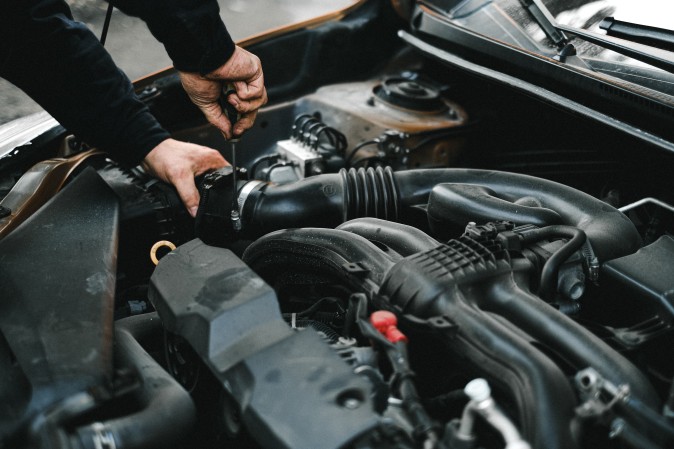Few components are as important as engine oil in the complex symphony of vehicle maintenance. The seemingly straightforward dipstick turns into a sentinel, providing an insight into the condition of your car’s vitals. Any automobile owner can get shivers down their spines when they find there is no oil on the dipstick; it raises serious concerns about the engine’s health. This thorough guide seeks to solve the puzzle around this unsettling discovery by offering a schedule for quick fixes, in-depth research, and precautionary steps. By the time we finish this comprehensive tutorial, you will be equipped with the knowledge necessary to deal with the problem of no oil on the dipstick, which will guarantee both the short-term and long-term health of your car.
Importance of Regular Oil Checks:
Frequent oil changes are the foundation of good automobile ownership; they are a necessary habit that is analogous to a living thing’s regular checkups for health. Oil is necessary for the engine, which is sometimes referred to as the “heart” of a car, to run smoothly and effectively. As a lubricant, engine oil reduces wear and tear, dissipates heat, and lessens friction between moving parts. But with time, this essential fluid deteriorates, losing its potency and perhaps jeopardizing engine efficiency. Frequent oil checks, represented by the uncomplicated but essential dipstick, enable vehicle owners to keep an eye on the oil’s quality and level, serving as a preventative precaution to guarantee the engine’s lifetime and health.

Reasons for no oil on dipstick:
There are several reasons why there could not be any oil on the dipstick, from regular engine running to possible problems that need to be fixed right away. The following are some typical explanations for why the dipstick could not show any oil:
Gradual Oil Consumption:
- Normal Engine Operation: It’s critical to understand that an engine’s natural oil consumption occurs throughout the operation. Engines may burn a tiny quantity of oil during combustion over time.
- Common Causes of Oil Consumption: Increased oil consumption can be caused by several things, including damaged valve seals, worn piston rings, and excessive engine miles.
Oil Leaks:
- External Leaks: Oil can be lost quickly due to leaks in the engine or other parts. Leaks in the valve cover gasket, an oil filter that is leaking, or damage to the oil pan are common causes.
- Internal Leaks: Oil can leak into the coolant or combustion chambers due to internal engine components like a fractured engine block or a failed head gasket, which lowers the oil level.
Incorrect Dipstick Reading:
- Improper Dipstick Insertion: The dipstick may provide a misleading reading of low oil levels if it is not placed correctly or is not fully inserted. Make sure the dipstick is inserted and fastened correctly at all times.
Oil Change Timing:
- Recent Oil Change: It might take some time for the fresh oil to circulate and settle in the oil pan if you recently changed the oil. If you check the oil too soon after changing it, the findings might not be correct.
Oil Pump Issues:
- Faulty Oil Pump: Lower oil levels can result from an oil pump problem that prevents the engine’s oil from being sufficiently circulated throughout. This is a serious problem that has to be addressed right away.
Oil Viscosity and Temperature:
- Cold Weather Conditions: The oil may thicken in colder weather, which makes it more difficult for the dipstick to register an accurate oil level. In chilly weather, warm up the engine before checking the oil.
- Severe Engine Damage:
- Catastrophic Engine Failure: Very rarely, a quick and substantial loss of oil can be caused by serious engine damage, such as a fractured engine block or a broken connecting rod.
Immediate Actions:
If there is no oil on the dipstick, you must act quickly to protect the engine from potential harm. When confronted with this uncomfortable scenario, you should take the following quick actions:
- Turn Off the Engine:
- To stop more harm, turn off the engine right away. Running the engine with little or no oil can increase heat and friction, which can wear out or seize important parts.
- Assess the Situation:
- Examine the engine compartment from the inside out. Keep an eye out for any indications of apparent oil leaks around the valve cover, oil pan, or other parts. Keep an eye out for any strange odors, smoke, or engine noises since these might point to a significant problem.
- Check for Visible Leaks:
- Look under the car for any obvious evidence of oil leakage. Finding the source of the leak might be aided by the presence of oil puddles or stains on the ground. It could be able to take care of an exterior leak right away.
- Examine for Smoke or Unusual Noises:
- Severe engine problems may be indicated by smoke coming from the engine or by strange banging or ticking noises. Make a note of these symptoms as these will be important details to know when you seek medical attention.
- Add Oil if Necessary:
- Add oil right away if the level is dangerously low. The owner’s handbook for your car will tell you what kind and viscosity of oil is appropriate. Add oil in small amounts using a funnel to minimize spillage, and make sure to periodically check the dipstick to avoid overfilling.
- Identify the Source of the Issue:
- Try to locate the cause of the issue as you apply oil. Make a note of where any obvious leaks are located. If adding oil doesn’t solve the problem, there can be an internal issue that has to be checked out by an expert.
- Avoid Driving:
- If at all possible, avoid using the car, particularly if the oil level is dangerously low. Insufficient oil in the engine might cause serious harm. If you must drive, use the quickest route available and drive carefully.
- Document Observations:
- Note any observations you make, such as the symptoms you saw, the date of the last oil change, and any recent repairs. When speaking with a mechanic, this information will be helpful.

Investigating the Cause:
After addressing the lack of oil on the dipstick right away, you should carry out a comprehensive examination to determine the underlying source of the problem. This is a methodical way to look at the reason:
Perform a Visual Inspection:
- External Components: Look for any obvious indications of leakage on the engine’s exterior parts, such as the oil pan, valve cover, and oil filter. Examine the vicinity for any signs of puddles or oil streaks.
- Hoses and Connections: Inspect hoses and connectors for indications of deterioration, leaks, or wear. Replace broken hoses and tighten any loose connections.
Check Under the Vehicle:
- Inspect the Ground: Look under the car for any recently formed puddles or oil marks. This may assist in locating an outside oil leak.
Monitor for Smoke or Odors:
- Engine Compartment: After starting the engine, check the engine compartment for smoke or strange smells. Odors of burning or smoke may be signs of oil seeping onto hot engine parts.
Oil Pressure Test:
- To measure the oil circulation in the engine, do an oil pressure test. Low oil pressure may indicate an obstruction in the oil channels or issues with the oil pump.
Inspect the Exhaust Pipe:
- Look for blue or white smoke coming from the exhaust pipe, since this might be a sign that oil is burning. A lot of smoke might indicate internal engine problems.
Seeking Professional Help:
After making the initial assessments and investigations and facing the mystery of no oil on the dipstick, getting professional assistance becomes essential to maintaining the longevity and health of your car. A qualified mechanic or automotive technician has the knowledge and diagnostic tools required to identify the source of the problem. Communication is essential during this process; give the professional a thorough explanation of your observations, any unusual symptoms, and the actions you have taken to address the issue. Professional assistance is especially important if the cause of the low oil level is still unknown or if there are indications of more serious internal engine problems.
Preventive Measures:
The lifetime and health of your car’s engine depend on preventive maintenance, which lowers the chance of problems like low oil levels. The following are crucial precautions to take:
- Scheduled Oil Changes:
- Follow the manufacturer’s suggested oil change schedule for your car. To keep engine parts lubricated and avoid excessive wear, use clean, fresh oil.
- Use the Right Oil:
- Use the oil type and viscosity recommended by the owner’s handbook at all times. Engine life and maximum performance are ensured by using the right oil.
- Monitor Oil Levels:
- Develop a practice of routinely checking the oil level with the dipstick. This simple job enables you to spot possible difficulties early and maintain optimum oil levels.
- Inspect for Leaks:
- Check for oil leaks often in the engine and below the car. Quickly fix any leaks to stop the oil from slowly leaking out.
- Check the Oil Filler Cap:
- After every oil change, make sure the oil filler lid is firmly in place. Engine oil leakage may occur from a missing or loose cap.
- Maintain the PCV (Positive Crankcase Ventilation) System:
- As advised by the manufacturer, check, and replace the Positive Crankcase Ventilation (PCV) valve regularly. An effective PCV system aids in preventing the crankcase from overheating.
- Engine Performance Monitoring:
- Keep an eye out for any changes in the engine’s performance, strange noises, or the emergence of dashboard warning lights. Timely intervention is made possible by early diagnosis of anomalies.
- Address External Leaks Promptly:
- Investigate any oil streaks or puddles beneath the car and take quick action to fix any exterior leaks. Ignoring leaks might result in a large oil loss.
- Inspect Gaskets and Seals:
- Check gaskets and seals for wear or damage during normal maintenance or while replacing components. Oil leaks might occur because of damaged gaskets.
- Regular Engine Inspections:
- Plan to have the engine inspected regularly by a qualified mechanic to determine its general condition. Potential problems can be seen by a skilled eye before they become more serious.
Frequently asked questions:
If the oil dipstick disappears, what happens?
Regularly checking oil levels is hampered if the oil dipstick vanishes. Low oil levels might result in engine damage as a result of this.
Can I operate a vehicle without an oil dipstick?
No, it is not advised to drive a car without an oil dipstick. It is difficult to check sure the engine has enough oil, which increases the possibility of damage when the dipstick is missing.
Is a dipstick accurate?
Yes, when used properly, a dipstick can measure oil levels rather accurately.
How does a dipstick display low oil?
When the level on a dipstick falls below the minimum point, it indicates low oil and indicates the need for an oil change or more oil.
Conclusion:
In summary, the lack of oil on the dipstick must be addressed right away and requires a methodical approach to diagnosing and fixing it. This thorough guide has given you information on reasons, what to do right away, how to look for the source of the problem, and preventative steps to keep the engine of your car in good working order.

